TIME TELLING MACHINES: Revealing marvellous mechanical and water-powered clocks from early Muslim Civilisation. These sophisticated devices that defied the Middle Ages.


Note: Composed by Cem Nizamoglu and first published in 1001 Inventions website.
Clocks and timekeeping were one of the most significant developments of Muslim civilisation. Scholars, inventors and craftsmen made innovative automata, carried out detailed mathematical analysis, constructed intricate clocks and attempted to master automatic control as they created and expanded upon inventions to mark and measure time.
| The Arabs [and non-Arabs from Muslim Civilisation] also made better and more accurate devices for measuring time, clepsydras or water-clocks. The earliest reference to a clock is found in al-Jahiz’s Kitab-al-Hayawan in the second half of the 9th centurys.” George Sarton* |
*Introduction to the History of Science Vol.11 Part II by George Sarton, Baltimore, William and Wilkins company, 1931, p.632.
|
Our kings and scientists use the astrolabe by day and the binkamat (water-clocks) by night” Al-Jahiz, Kitab-al-Hayawan |
This may be the earliest record of clocks in Muslim Civilisation history. However, the quote itself shows that the usage of clocks was a common practice in and before 9th Century – maybe even the making of clocks. Clock-makers from Muslim Civilisation indeed, used Indian and Greek technology. Though Archimedes book on the water-clocks was not just preserved in Arabic – advancement and the creativity in building clocks became a form of art like the astrolabes. This also contributed towards the development in automata and other technological advancements. .


Figure 2. The internal workings of a water-clock. From ‘The Book of Archimedes on the Construction of Water-Clocks’ in Arabic. Or. 14270, f. 16v (Source)
| As in the west so in the east, but here we have far more information. In the hands of Arab scholars [and non-Arabs from Muslim Civilisation] not only was the Greek tradition of water clocks developed, but detailed descriptions were written by the compilers of The Book of Archimedes on the Construction of Water-Clocks (eighth to twelfth centuries); by al-Muradi (eleventh century); al-Khazini (early twelfth century); Ridwan (late twelfth to early thirteenth century); and al-Jazarl (late twelfth to early thirteenth century).”* |
*Encyclopedia of Time by Samuel L. Macey, Routledge, 2013, Page 310
‘Stand the test of time’ clocks have been used in Muslim Civilisation from the early ages of Islam. ‘Time is of the essence’ clocks turned from a development in technology to an art form. Huge clocks, sometimes reaching 6 meters high, were designed by the likes of Al-Jazari and others. ‘In time’ towers, mosques and even whole streets turned in to clocks, for example with the construction of clocks such as the Bou’Anania clock (see figures 22-24) . ‘As time goes by’ not just in automata, robotics or other technologies, clock development competed with astrolabe development in astronomy in example Taqi al-Din’s Astronomical clock (see figures 7-8). ‘There was a time when’ sending clocks as gifts became a policy between nations; it even reached from Ottomans to Mexicans (see figures 38). ‘Once upon a time’ in Europe, a figure on a clock of the ‘French Charles X in Ottoman outfit riding an Arab stallion’ (see figure 25), demonstrating how clocks even became a fashion statement (see figures 35-36). Most importantly, clocks were a shared legacy, especially clocks from Muslim Civilisation were “ahead of their time”. One only needs to observe how Archimedes works were preserved in Arabic (see above figure 2) or how Al-Jazari’s “Elephant clock” embodied Indian, Persian, Greek, Egyptian, Chinese and Arabic elements almost as if it was an united nations’ clock (see figures 15-16) . ‘Only time will tell’ but to take one nation’s contribution out would be taking one gear out from a clock… hopefully you will find much more information and examples in Professor Al-Hassani’s upcoming book on clocks; ‘all in good time’…
Here are some key examples:


Figures 3-4. Manuscript view of the castle clock (Left) and computer assisted reconstruction (Right) © 1001 Inventions
The first machine described by Al-Jazari in his famous treatise of mechanics Al-Jami‘ bayn al-‘ilm wa ‘l-‘amal al-nafi‘ fi sina‘at al-hiyal (‘A Compendium on the Theory and Useful Practice of the Mechanical Arts’) is a monumental water clock known as the Castle Clock.
The castle water clock is one of the grandest clocks mentioned in Al-Jazari’s book. Details of its construction and operation are described in ten sections of the first chapter of Category I of the treatise.
The clock, with its series of mechanical routines that ran throughout the day, would have been very pleasing to watch and listen to. During daylight hours, an observer would have seen the Sun’s disc on the eastern horizon about to rise, the Moon would not be seen at all and six zodiac signs would be visible, while the first point of the constellation Libra was about to set.
The crescent Moon would travel steadily from left to right on the frieze. When between two doors, the upper door would open to reveal a figure of a man, while the lower door flipped round to reveal a different colour. This occured as each solar hour of sunlight has passed. Soon after this happens, the two falcons would tilt forward and spread their wings, and a ball would drop out of their beaks and into the vase. The observer would hear a cymbal-like sound, and both falcons would lean back to their original position and close their wings…
Muslim Heritage: Al-Jazari’s Castle Water Clock by Salim Al-Hassani
| It is impossible to over-emphasize the importance of al-Jazari’s work in the history of engineering. Until modern times there is no other document from any cultural area that provides a comparable wealth of instructions for the design, manufacture and assembly of machines… Al-Jazari did not only assimilate the techniques of his non-Arab and Arab predecessors, he was also creative. He added several mechanical and hydraulic devices. The impact of these inventions can be seen in the later designing of steam engines and internal combustion engines, paving the way for automatic control and other modern machinery. The impact of al-Jazari’s inventions is still felt in modern contemporary mechanical engineering…” Donald R. Hill |
***


Figure 5. Dome of the clocks in the courtyard of the of Umayyad Mosque in Damascus. © Bernard Gagnon (31 March 2010)
Originally built in the famous Umayyad mosque in Damacus more than 800 years ago, this clock was re-constructed by Ridhwan al-Sa’ati. This impressive mechanical clock displayed the time numerically and included two falcons that would automatically throw a copper ball into a vase to mark the passing of an hour. At night, a lamp would be lit to indicate the hour by shining through a turning disc.


Figure 6.The general plan of the Umayyad mosque water clock as drafted by Ridhwan al-Sa’ati in his original manuscript.
According to descriptions by Ibn Jubayr, geographer, traveler and poet from al-Andalus (Muslim Spain), the clock had both an upper level and a lower section.
The lower section housed the engine that generated the movements and transmitted them by ropes and pulleys to the upper part. The engine worked by means of a float in a water tank (bankan). Upon draining the water from the tank, through an orifice at the bottom, the float moved down under the force of gravity, pulling a rope over a pulley which caused the movement of all the other parts. The float movement was controlled by the speed with which the water surface moved down in itself regulated by a control valve attached to the orifice.
Muslim Heritage: From Frankfurt and Cairo to Damascus by Abdel Aziz Al-Jaraki
| In 1154. Arab engineer al-Kaysarani constructed the world’s first striking clock. near the Umayyad mosque in Damascus. It was powered by water and was described by at-Kaysarani’s son Ridwan al Sa’ati in his 1203 treatise On the Construction of Clocks and their Use. Islamic water clocks became so sophisticated that in 1235 one was built in Baghdad that told people the times of prayer, day and night.” DK* |
*Science Year by Year by Dorling Kindersley (DK) Ltd, 2013, Page 57
***
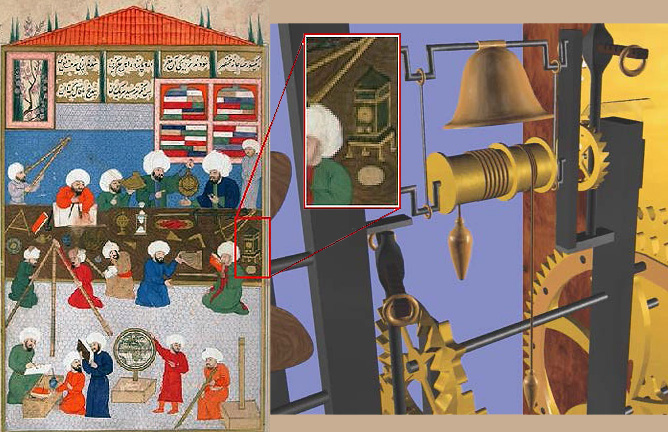

Figures 7-8. In the middle part of this famous manuscrtipt of an Istanbul observatory (left) is a clock placed on a table that is believed to be Taqi al-Din’s. Computer animated rendering of the workings of Taqī al-Dīn’s observational clock is shown on the right. © 1001 Inventions
In his book ‘The Brightest Stars for the Construction of Mechanical Clocks’ (Al-Kawakib al-durriyya fi wadh’ al-bankamat al-dawriyya), Taqi al-Din Ibn Ma’ruf analyses the four main types of time keeping devices known in the 16th century: watches, domestic clocks, astronomical clocks and tower clocks. Such machines represent the earliest mechanical computers.
Before the 16th century, clocks were considered too inaccurate for measuring celestial movements. Where Ptolemy failed to succeed in, Taqī al-Dīn planned to build an astronomical clock that would measure time with great regularity in fulfillment of the wish of the Sultan at the time.
Using mathematics, he designed three dials which showed the hours, degrees and minutes. In his clock, he incorporated the use of several escapements, an alarm, the striking trains that sounded at every hour, the visual relationship between the sun and the moon, the different phases of the moon, the devices that indicated the time for prayers and the dials that showed the first day of the Gregorian months.
Taqī al-Dīn’s work on mechanical clocks is of important significance in light of transmission of knowledge between cultures and advancement of technology within the Middle East in the middle of the 16th century. Many of the devices mentioned in his clock are present in today’s clocks from all around the world.
Muslim Heritage: The Astronomical Clock of Taqi Al-Din by Salim Al-Hassani
| Regarded as the greatest scientist and engineer of the Ottoman Empire, and one of the last of the great Islamic polymaths, Taqi al-Din made significant contributions to areas as diverse as optics, horology, hydraulics, and steam power. He wrote more than 90 books on a wide variety of subjects, ranging from astronomy and natural philosophy to engineering, clocks, mathematics, and mechanics, which contain detailed descriptions and discussions of his work. Many of these treatises were translated into European languages and reached the West.” Adam Hart-Davis* |
*Engineers by Adam Hart-Davis, Dorling Kindersley Ltd, 2012, Page 56
***


Figures 9-10. Al-Muradi describing the solar clock in his “Book of Secrets” (on the left), 3D computer animated image of solar clock (on the right)
Some of the earliest descriptions in Arabic of water clocks are available in Al-Muradi’s ‘The Book of Secrets’, there has been found some of the earliest descriptions in Arabic of water clocks. This book deals with water clocks and other devices that use automata. The treatise consists of 31 models of which five are essentially very large toys similar to clocks, in that automata are caused to move at intervals, but without precise timing.
There are nineteen clocks all of which record the passage of the temporal hours by the movements of automata. The power came from flowing water, and it was transmitted to automata by very sophisticated mechanisms, which included gears and the use of mercury. These are highly significant features; they provide the first known examples of complex gearing used to transmit high torque, while the adoption of mercury reappears in European clocks from the thirteenth century onwards.
Unfortunately, the only known manuscript of this work is badly defaced and it is not possible to understand exactly how the clocks worked. A weight-driven clock with a mercury escapement appears in “Libros del Saber”, a work written in Spanish at the court of Alfonso of Castille in about 1277 and consisting of translations and paraphrases of Arabic works. A novel feature in this treatise is the use of mercury in balances. Al-Zarquali built two large water clocks on the banks of the river Tagus at Toledo in 11th century.
Muslim Heritage: A Review of Early Muslim Control Engineering by Mohamed Mansour
| When I looked at the science of engineering and saw that it had disappeared after its ancient heritage, that its masters have perished, and that their memories are now forgotten, I worked my wits and thoughts in secrecy about philosophical shapes and figures, which could move the mind, with effort, from nothingness to being and from idleness to motion. And I arranged these shapes one by one in drawings and explained them.” Al-Muradi* |
*“Kitab al-Asrar fi Nataij al-Afkar” (Book of Secrets) by Al-Muradi, source: www.leonardo3.net
***


Figures 11-12. Photo (Right) of the Al-Lija’i clepsydra clock located in the room of al-Muwaqqit (timekeeper) in the minaret of the Al-Qarawiyyin mosque (Left) in Fes, Morocco. © 1001 Inventions
Amongst the most remarkable historical objects in the Maghrib are the clocks in Fez in Morocco. One of these, a water clock operated by levers and strings and without any complicated gear mechanisms, was located in a room in the minaret of the Qarawiyyin Mosque. It was made in 1286/87 by Ibn al-Habbak al-Tilimsani, and when it was restored in 1346-48 by Abu Abdallah al-‘Arabi it was fitted with an astrolabic rete to help track the stars. Alas, the driving mechanism behind the clock is lost without trace, and it is not clear what changes have been made to the front of the clock. But fortunately, the astrolabic part survives to this day. It is housed in a cabinet 2.4 meters high and 1.2 meters square; the rete is about 40 cm in diameter and would have rotated once every 24 hours. It thus could imitate the apparent daily rotation of the heavens about the horizon of Fez, a kind of model of the universe in two dimensions. In addition, metal balls would fall through the doors above the clock every hour.
The muwaqqit was the officer charged with the regulation and maintenance of the clocks and with communicating the correct times of prayer to the muezzin who would lead the call to prayer. The most important object of the Dar al-Muwaqqit is the water clock of Al-Lija’i made at the order of the Marinid Sultan Abu Salim Ali II (r. 1359-1361) by Abu Zaid Abdurrahman Ibn Suleyman al-Lija’i (d. 1370). Notice the 12 doors under and above the disk; the red wooden structure is the top part of the clock. Source: La clepsydre Al-Lijai.
Muslim Heritage: History, Culture, and Science in Morocco by Salah Zaimeche
| The tradition of building monumental water-clocks continued in Islam after the time of al-Jazari, as is proved by the remains of two large constructions dating to the 8th/14th century in Fez, Morocco.’ The first of these, at the Bu`ananiyya Mosque... The second clock is located in the upper room in the minaret of the Qarawiyyin University Mosque. It was built in 736/1362 by Abu `Abd Allah Muhammad al-Arabi, on the site of two earlier clocks. It is fitted with an astrolabic rete and an elegant fixed dial, the rate being carried on a wooden axle projected into the interior chamber. This is, therefore, a similar device to the anaphoric clock described by Vitruvius…” Donald R Hill* |
*Sources & Studies in the History of Arabic-Islamic Science History of Technology, Series – 4 – Arabic Water-Clocks by Donald R Hill, University of Aleppo, 1981, Page 123
***
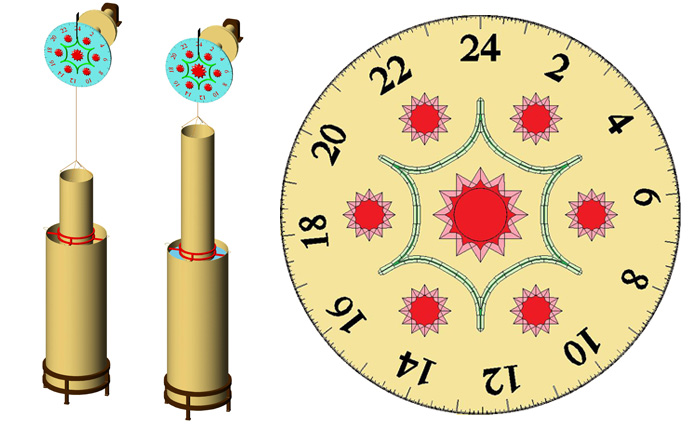

Figures 13-14. 3D animation images of the reconstructed model of Ibn al-Haytham’s clock. © 1001 Inventions
Better known for his ground-breaking discoveries in optics, Ibn al-Haytham’s work on the water clock (Maqala fi ‘amal al-binkam) is also very significant.
In his writings, Ibn al-Haytham gives details of the water clock. He describes it as a new invention in that it gives hours and minutes, which no other clock had previously shown. He refers to making and manufacturing the clock, as well as testing it by trial and error.
The time-measuring mechanism he used was a cylinder with a small hole at its base as the prime mover for telling the time. As the cylinder sank downwards into another tank, which contained a sufficient amount of water, it resembled an inflow clepsydra, measuring time by the amount of water that had flowed in. This was unlike the clepsydras used in antiquity, which were later adapted by Muslim engineers Al-Muradi, Ibn Ridhwan al-Sa’ati and Al-Jazari. These were all outflow clepsydras, measuring time by the amount of water that had flown out. It is interesting that Ibn al-Haytham should use inflow technology for the control of his clock instead of the outflow clepsydra, which should have been well known in Cairo at the time when he was in Egypt.
Muslim Heritage: The Mechanical Water Clock Of Ibn Al-Haytham by Salim Al-Hassani
| In the ninth century, an elaborate water-clock was presented to Charlemagne by vassals of Harun al-Rashid, an indication that these devices were made in early Abbasid times. In his Book of the Balance of Wisdom, written about AD 1121, al-Khazini refers to various water-clocks built by his predecessors, in particular the great Egyptian scientist Ibn al-Haytham (965-1039).” Donald R Hill* |
* A History of Engineering in Classical and Medieval Times by Donald R Hill, Routledge, 2013, Page 232
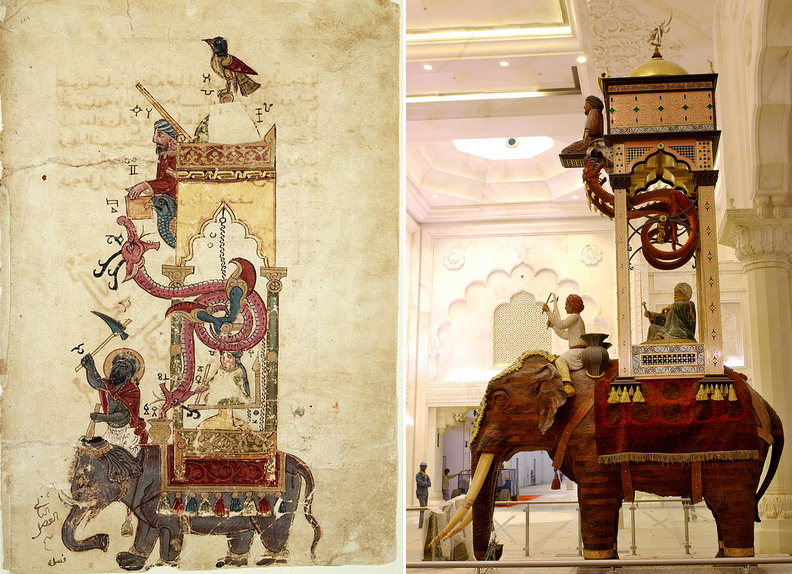

Figures 15-16. Elephant Clock manuscript by Al-Jazari from The Book of Knowledge of Ingenious Mechanical Devices (Left) A reproduction of the elephant clock in the Ibn Battuta Mall, Dubai (Right)
Al-Jazari’s 800-year-old automatic Elephant Clock is probably the most famous of clocks from Muslim civilisation.
The large clock uses Greek water-raising technology, an Indian elephant, an Egyptian phoenix, Arabian figures and Chinese dragons, to celebrate the diversity of the world.
Muslim Heritage: Overview on al-Jazari and his Mechanical Devices by Yavuz Unat
| The Holy Qur’an encourages Muslims to seek knowledge throughout their lives, no matter what the source or where it might lead geographically. Islamic civilizations have celebrated and worked towards cross-boundary knowledge sharing. Al-Jazari, for example, once built an elaborate clock, the Elephant Clock, in order to celebrate the diversity of mankind and the universal nature of Islam. It depicted different Greek, Indian, Phoenician, Chinese and Persian artifacts on the clock as, by that time, the Muslim world had spread from Spain to Central Asia.” Caroline Ellwood* |
*Learning and Teaching about Islam: Essays in Understanding by Caroline Ellwood, John Catt Educational Ltd, 2012, Page 31
A short film on Al-Jazari’s Elephant Clock below:
***
According to Al-Djazairi* there are “Flawed Claims Relating to Technological Breakthroughs” and one of this claims was related to clocks:
…the claim that there had been no technological advances between Antiquity and the ‘Renaissance is expressed by Bedini:
| There appears to be no longer any question, on the basis of recent research, that the mechanical clock and fine instrumentation evolved in a direct line without substantial change from the mechanical water clocks of the Alexandrian civilisation, transmitted through Islam and Byzantines.” Silvio A Bedini* |
*The Role of Automata in the History of Technology; in Technology and Culture Vol 5 by S A Bedini pp 24-42; at p. 29.
This is a misconceived view (although shared by many.) It first of all contradicts the view of medievalist historians who, correctly, give the Middle Ages a leading place in technological breakthroughs, including the development of mechanical clocks and fine instruments. Moreover, as Hill, most certainly the scholar giving most attention to technology from Muslim Civilisation, notes, fine technology is a recognizable Muslim profession, and if any modern engineer:
| Might refer to Greek works, he could find most of his inspiration in the works of his Muslim predecessors. A similar process that can be observed with other sciences and technologies.” Donald R. Hill* |
*Engineering in the Encyclopaedia by Donald R. Hill (Rashed ed), op cit, pp. 751-95; at p. 786.
This can easily be verified by comparing both traditions, the Greek and the Muslim to realise, indeed, that the latter bears the strongest affinities with modern technology, with respect to every single device. A valuable recent article by Aiken on the impact of Al-Jazari (fl. 1206) goes a long way to prove this point. The ingenious complexity of his devices, as well as his desire to instruct followers in the art and science of making them, Aiken points out, compelled al-Jazari to provide more detailed written descriptions of their inner workings than those found in any known older treatise. The instructive value of al-Jazari’s innovative drawings are obvious when compared to the typically more abbreviated illustrations found in a 13th century copy of Hero of Alexandria’s Pneumatica of the first century. As one might expect not only does Hero hardly mention the manufacturing process in the text of his treatise, he never explains how to construct any part of the machine, no matter how critical. By contrast, al-Jazari’s text and illustrations represent the growing importance and status of mechanical arts in the Middle Ages as well as their association with the most sweeping kinds of earthly, philosophical, and cosmological order.
| Perhaps, [Aiken says] most important from the point of view of understanding more about the perceptual and intellectual context of Renaissance perspective and of medieval technical drawings, al-Jazari’s illustrations express a fundamental need for the visual communication of useful information about material reality in an age when pictures are most closely associated with the aspatial, the iconic, and the other-worldly.”Jane Andrews Aiken* |
*Truth in images from the technical drawings of al-Jazari by J A Aiken, Campanus of Novara, 1994; pp. 325-359; at p. 344.
*From “The Hidden Debt to Islamic Civilisation, Volume II” by Al-Djazairi, S.E..
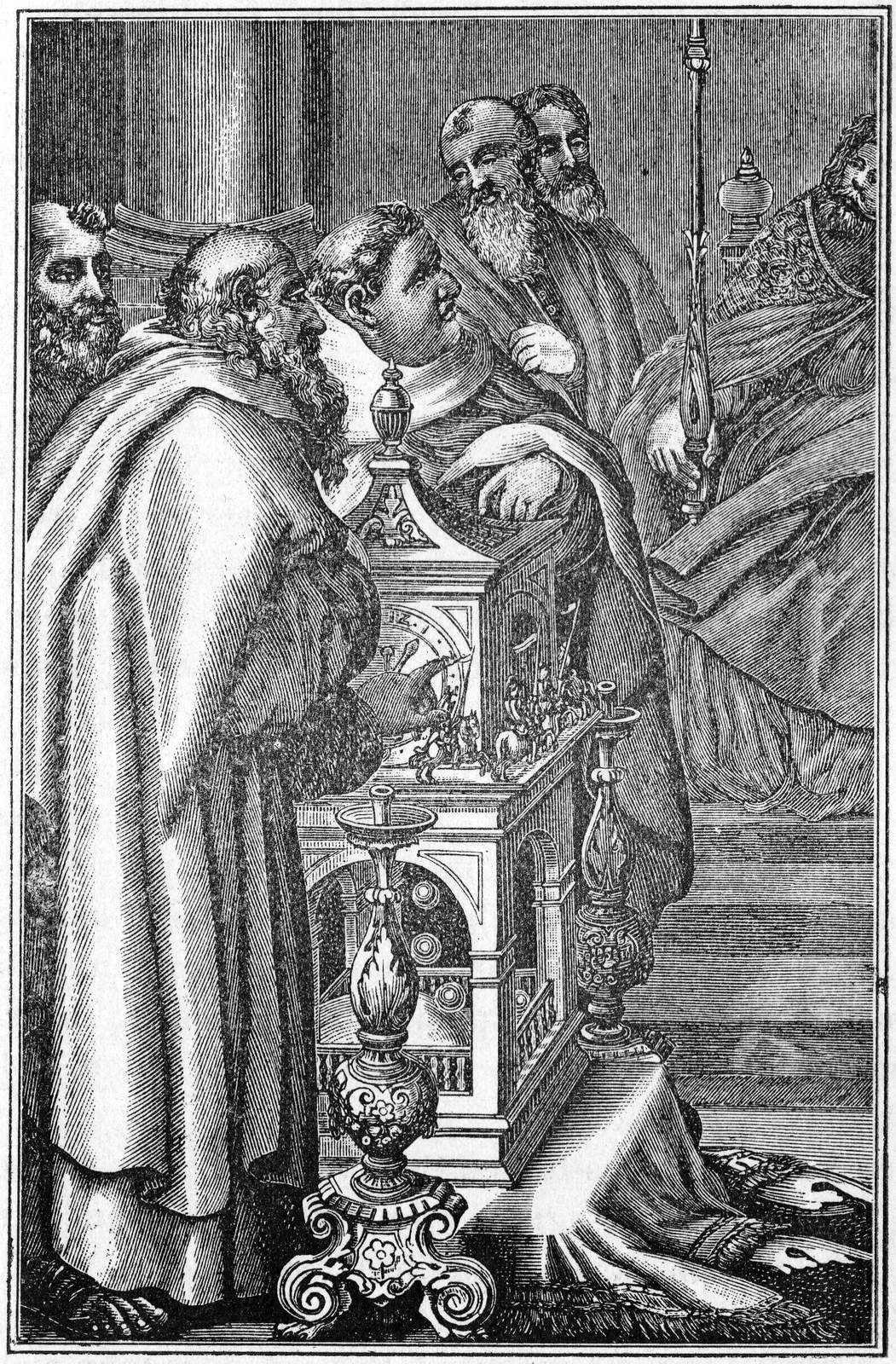

In 807, Emperor Charlemagne was sent a brass clock by the Abbasid caliph, Harun al-Rashid in Baghdad. According to the Emperor’s biographer, it was a “marvellous mechanical contraption, in which the course of the twelve hours moved according to a water clock, with as many brazen little balls, which fell down on the hour and through their fall made a cymbal ring underneath. On this clock there were also twelve horsemen who at the end of each hour stepped out of twelve windows, closing the previously open windows by their movements.” bookdrum.com: Charlemagne’s Elephant by Richard Hodges (Figure 17. Imaginary image of the scene, on the right)
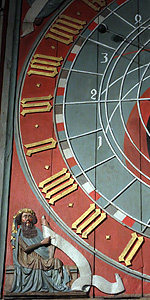  Fig18. Left side of the clock Lund Cathedral Clock |
“While in the cathedral, I walked over to the medieval astronomical clock to await the moving figures and music that accompany the striking of the hour. During my wait, I noticed four carved figures that had been placed in each of the corners of the top part of the clock. The figures were wearing exotic clothing and one even wore a turban, immediately bringing to mind the image of an Arabic astronomer. This challenged my previous assumption that Muslims had generally been portrayed in a negative light in medieval Scandinavia. Indeed, it actually seemed to suggest that there was a sense of pride in having these figures here occupying a prominent place within the walls of one of medieval Scandinavia‟s most important ecclesiastical buildings. This encounter tied in with research that I had been undertaking on the influence and dissemination of Arabic scientific works in Scandinavia, particularly in Iceland…”
Dr Christian Etheridge |
  Fig 19. Right side of the clock Lund Cathedral Clock |




Figure 20-21. Al-Jazari’s Scribe Clock from a copy of his book (Left) and replica from 1001 Inventions (Right)




Figure 22. Exterior view of clock of Bu ‘Inaniyya Madrasa (Source)
Dar al-Magana, Madrasa al-Bu’inaniya / Bou Anania / clock, Fez Souk Tala’a Kibeera, Fez, Morocco


Figure 23. View from below (Source)


Figure 24. Magana Bouanania / Dar al-Magana Reconstructed (Source)


Figure 25. Antique French Charles X clock with Hellenistic interest being a Turk or Ottoman mounted Arab stallion (Source)


Figure 26. Reconstruction of the clock of Al-Muradi by Spanish scholars. A general view with its side opening revealing the working of the mechanism. Source: Eduard Farré Olivé , De Mensura Temporis. (1ª parte) “Arte y Hora” n. 123-H6, March-April 1997, pp. 8-16 (2ª parte) “Arte y Hora” n. 127-H10, January-February 1998, pp. 10-17; and Eduard Farré Olivé, La clepsidra de las Gacelas del manuscrito de relojes de Al-Muradi.


Figure 27. Al-Jazari’s Elaphant Clock done by children (Source)




Figure 28. Similar to Al-Jazari’s Elaphant Clock “Water clock of the boat”
Figure 29. Rear view of the water clock mechanism (Source)
and many others can be find here


Figure 30. Al-Jazari and “The Book of Knowledge of Ingenious Mechanical Devices” from BBC’s Dick and Dom’s “Absolute Genius” (Source)


Figure 31. Professor Salim al-Hassani with Dick and Dom in the Bodleian Library, looking at the one of the rare copies of Al-Jazari’s clock Manuscript, University of Oxford (Source)




Figure 32. Mechanical clock of Taqī al-Dīn. Image taken from Sifat ālāt rasadiya bi-naw’in ākhar. (Source)
Figure 33. Al-Biruni’s Mechanical Calendar (British Library, MS OR 5593).


Figure 34. Scholar Studying the Workings of a Clock, Ottoman Manuscript, 17th century (Source)
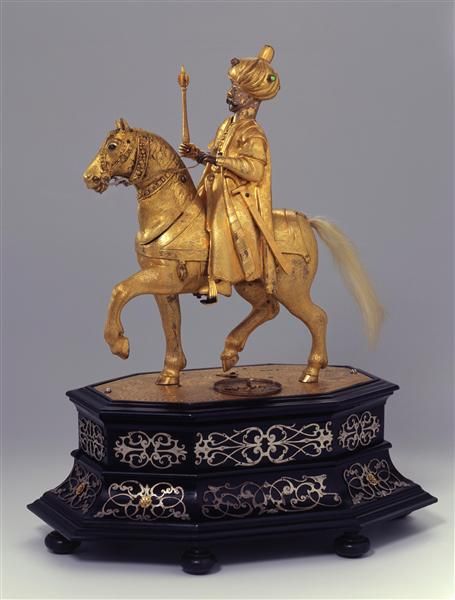



Figure 35. The clockwork automaton “The Riding Turk”, ca. 1585, probably made in Augsburg. At Staatliche Kunstsammlungen Dresden. (Source)
Figure 36. “Clock featuring a pasha on horseback. Southern Germany, ca 1580-1590. Gilded copper and iron. Now in the Kunsthistorisches Museum in Vienna.” (Source)
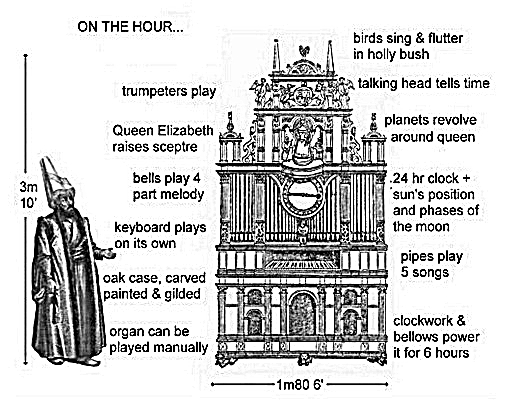

Figure 37. Queen Elizabeth I (Thomas Dallam’s Organ) clock gift to Ottoman Sultan Mehmet III 1599 (Source)




Figures 38. Ottoman Clock (Reloj Otomano) in Mexico City’s given as a gift by Sultan Mehmet V to Mexico in 1910 (Source)




Figure 39. Front view, Sarajevo clock tower. (Source).
Figure 40. Close up of the Ottoman clock dial which still displays Arabic numerals (Source).
Muslim Heritage:
Send us your e-mail address to be informed about our work.
This Website MuslimHeritage.com is owned by FSTC Ltd and managed by the Foundation for Science, Technology and Civilisation, UK (FSTCUK), a British charity number 1158509.
© Copyright FSTC Ltd 2002-2020. All Rights Reserved.
